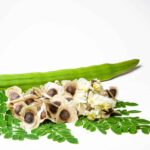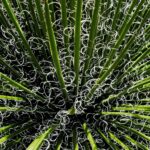Growing green onions is like baking a cake – it takes the right ingredients and the perfect combination of them to make something delicious. The end result is a plant that delights all the senses: the sight of verdant stalks and vivid green leaves, the smell of freshly cut herbs, and the taste of just-picked scallions. But how do you get there? Growing green onions from seeds or regrowing them doesn’t have to be difficult; with these simple steps, you can have your own green onion patch in no time.
As a botanist and gardener, I know how important it can be to know that your plants will flourish in your garden. That’s why I’m sharing my tips on growing green onions from seed or regrowing them quickly and easily. Whether you’re looking for an easy way to spruce up your kitchen windowsill or wanting to create a flourishing bed of fresh herbs outdoors, I’m here to help!
For anyone looking for an easy way to add flavor and nutrition to their meals, look no further than growing green onions. With just a few supplies and basic instructions, you’ll be well on your way to creating a stunning outdoor oasis or flavorful kitchen addition. Read on for my top tips on how to grow scallions from seeds or regrow them quickly and easily!
Choose A Variety Of Green Onion
Choosing the right variety of green onion is critical for a successful and abundant harvest. For those looking to grow their own onions from seed, there are various types available on the market. These include bunching scallions, which have long white stems and dark green leaves, as well as more traditional varieties such as Spanish onions and sweet onions. Depending on the region you live in, it’s important to select a variety that is suited to your climate. For example, some varieties thrive in hot and humid areas while others prefer cooler temperatures.
When selecting a type of onion, also consider the flavor profile you desire. Some onions have a milder taste while others may be spicier or sweeter. There are even some purple varieties with unique flavors that can add extra depth to recipes. Additionally, think about how much space you have available for planting; while some onions require more room than others, all will need adequate soil drainage to prevent them from becoming waterlogged.
Once you’ve selected the perfect variety for your area, you’re ready to start growing! Before getting started, it’s important to make sure your soil has been properly prepared; this includes tilling it up and adding plenty of organic matter like compost or manure for additional nutrients. Additionally, add a slow-release fertilizer if needed and keep an eye out for weeds that can compete with your scallions for light and moisture. With proper care and attention throughout the growing season, you’ll be enjoying freshly harvested green onions in no time!
Obtaining Or Purchasing Seeds
With the right preparation and planning, you can grow your own green onions from seed. A wise gardener once said that ‘the start of any garden is the seeds’ – and this couldn’t be more true for growing green onions. Obtaining or purchasing the right seeds is an important step in ensuring a successful harvest of green onions.
For those looking to purchase their seeds, it is important to look for varieties that are bred specifically for scallions or green onions, as these will have the strongest flavor. Additionally, pay attention to the packet size and how many days you can expect them to take until they fully germinate. Generally, it should take between 7-10 days before you can see the first sprouts emerge.
If starting from seed isn’t an option, then regrowing is still possible with leftover onion bottoms from the grocery store. Simply place them in water and keep changing out the water daily until roots appear at the bottom of each root section of each onion top. Once roots have appeared, transplant them into soil and let nature take its course! With proper care, you should have fresh green onions within no time!
Selecting A Location To Plant
Once you have obtained your seeds, you must now select a suitable location in which to plant them. It is important to choose an area that gets plenty of sunlight and has well-draining soil. If planting in containers, use pots that are at least 8 inches deep and 12 inches wide. This will give the onions enough space for the roots to grow and spread out.
When selecting a location for planting green onions, it’s also important to consider other factors such as temperature, wind direction, and irrigation methods. A spot that receives direct sun during the day is ideal for onion growth as it encourages rapid foliage development. Additionally, make sure to avoid locations with high humidity or cold temperatures as this can cause stunted growth in the onions.
Furthermore, be mindful of prevailing winds when selecting a spot for growing green onions as strong gusts can cause damage to the plants. Also consider how you will be irrigating your onions; a drip system works well when planted in the ground whereas hand-watering is more suitable when grown in containers. With these tips in mind, you should be able to find an appropriate place for planting your scallions!
Preparing Soil For Planting
The fourth step in the process of growing green onions is preparing soil for planting. This is an essential part of the process and cannot be overlooked. Generally, soil should be well-draining and lightly acidic, with a pH between 6.0 and 6.5. Adding organic matter to the soil, such as compost or aged manures, can increase its fertility and help maintain moisture levels in the soil.
To make sure your green onions are healthy and strong, it’s important to loosen up the top layer of soil before planting. You can do this by using a shovel or tiller to remove any existing weeds or roots from the area where you plan to plant your scallions. To protect against weeds emerging during their growth, consider adding a layer of mulch around your green onion seedlings after planting them into the ground.
Once you have finished preparing your soil for planting, it’s time to sow the seeds! Make sure that you place them at least one inch apart from each other so that they will have enough space to grow properly. Watering regularly is also necessary for successful germination; ensure that your scallions get about an inch of water per week (more during hot weather). With proper preparation and care, you’ll soon be able to enjoy delicious homegrown scallions!
Sowing The Seeds
Well, it looks like the hard part is done. You’ve prepared the soil, and all that’s left is to sow the seeds. As our resident botanical specialist, you may have expected this to be a simple matter of sprinkling some seeds on the ground, but there’s more to it than that. Believe it or not, there are some special tricks for getting your green onions off to a great start!
First and foremost, make sure you sow your seeds evenly around the garden bed. If you’re planting more than one variety of onion at once, be sure to separate them so that they don’t cross-pollinate each other. Next, cover the seeds with a thin layer of compost or fertilizer to give them an extra boost of nutrition. Finally, water thoroughly until all the seeds have been moistened but not flooded—this is key for successful germination!
So there you have it: sowing your green onion seeds doesn’t have to be tricky if you follow these steps carefully. With any luck and a bit of TLC (tender loving care), your scallions will soon be sprouting and ready to harvest!
Caring For Your Green Onions
Once you have successfully sown the seeds of your green onions, caring for them properly is essential to ensure a healthy harvest. To maximize their growth and yield, proper watering and fertilizing are key components of success.
When it comes to watering your green onions, consistency is essential. To maintain the right amount of moisture in the soil, water your plants regularly – but not too much! It is important to avoid overwatering as this can lead to root rot and other issues which could harm the health of your plants. Additionally, when watering it is best to water at the base of the plant instead of from above. This helps reduce the risk of fungal diseases.
When it comes to fertilizing your green onions, choose a fertilizer that has plenty of nitrogen in it such as fish emulsion or compost tea. Fertilize every two weeks during the growing season for optimal growth and yield. Keep in mind that if you add too much fertilizer, you may end up with an unhealthy plant with weaker stems and smaller harvests.
TIP: When caring for your green onion plants, keep a close eye on them and make sure they have adequate space between each other so they don’t become overcrowded – this will help them grow bigger and stronger!
Watering And Fertilizing
Watering and fertilizing your green onions is like watering a thirsty plant: it’s essential for its growth and vibrancy. As a botanist and gardener, I specialize in this area, so let me give you some tips on how to keep your green onions hydrated and nourished.
First off, you want to water your scallions on a regular basis. When the top inch of soil feels dry, it’s time to water the onions. Make sure that you don’t overwater them – too much can cause the roots to rot and become diseased. Additionally, you’ll want to fertilize your scallions every few weeks with a balanced fertilizer or compost tea. This will help keep the soil nutrient-rich so that your scallions can reach their full potential.
Finally, make sure to pay close attention to the condition of your green onions – keep an eye out for any signs of wilting or discoloration. If this happens, take immediate action by adjusting the amount of water or fertilizer given accordingly. With proper care and attention, your scallions will thrive in no time! With these tips in mind, let’s move onto controlling pests and diseases which may affect your green onion crop.
Controlling Pests And Diseases
Gardening can be a tricky business. It requires knowledge, skill, and dedication to make sure your plants are healthy and strong. But when it comes to controlling pests and diseases in your green onions, the stakes become even higher. You don’t want any pesky bugs or fungi ruining your hard work. So let’s dive into how to keep them away from your scallions!
Firstly, it’s important to recognize the signs of pest infestation or fungal disease early on. This can include discoloration of leaves or stems, wilting foliage, or damaged roots. If you spot these symptoms, take action immediately by removing any affected plants and disposing of them properly. Additionally, keep an eye out for common garden pests like aphids and spider mites which can quickly spread if left unchecked.
The good news is that there are plenty of ways to prevent pests or disease before they occur. Consider rotating crops each year in order to avoid repeating the same problem areas in the same spots every season. Use organic mulch around the base of your plants to help retain moisture while also deterring common pests like slugs and snails. Lastly, during dry spells be sure to water your scallions regularly as over-watering can lead to mold growth and other fungal issues.
With these tips in mind you should have no problems keeping unwanted critters away from your green onions – allowing you to enjoy a successful harvest!
Harvesting Your Green Onions
Harvesting your green onions is a momentous occasion in any gardener’s life. It marks the end of weeks of hard work and patience, and the beginning of reward! When it comes to harvesting green onions, there are two ways to do it: from seed or from regrowing.
Imagining the freshness of just-picked scallions, with their crisp and crunchy tops, is enough to make any botanist salivate! To harvest from seed, it’s important to wait until the plants have reached at least 8 inches in height. Then you can carefully cut off the tops, leaving a few inches of stem still intact on the plant. This will allow them to continue growing new shoots so you can enjoy multiple harvests later on.
When it comes to regrowing green onions, timing is everything! The best time to harvest is when your plants have reached 6-8 inches in height, but before they start flowering. This will give you optimal flavor and texture in your scallions – perfect for adding that beautiful pop of color and flavor to any meal! With careful harvesting and proper care, you can enjoy multiple harvests throughout the season. So get out your scissors and let’s get harvesting!
Storing Your Green Onions
Once the green onions are ready to be harvested, it’s time to store them properly and ensure they last. Storing your freshly harvested green onions is like a delicate dance between maintaining the perfect temperature and humidity levels. As any gardener worth their salt knows, this complicated choreography can be tricky to master.
As a botany specialist with years of experience in gardening, I understand that there are several important details to consider when storing green onions. To start off, you must keep your green onions at a cool temperature; ideally around 32 degrees Fahrenheit or lower. Additionally, you want to make sure that the air surrounding the green onion is not too dry or too humid. If done correctly, your green onions will remain crisp and flavorful for weeks on end.
On top of temperature and humidity control, you should also consider light exposure when storing your green onions out of the ground. Keeping them away from direct sunlight is key if you want to maintain their freshness and flavor. However, some indirect light won’t hurt as long as it’s not too strong or concentrated in one area for an extended period of time.
With these considerations in mind, you should have no problem preserving your freshly harvested green onions for later use! Nowadays regrowing these delicious vegetables is becoming increasingly popular due to its ease and environmental friendliness; so let’s dive into that next!
Regrowing Green Onions
Did you know that green onions are one of the most popular plants among home gardeners? It’s no surprise, as they are relatively easy to grow and can be harvested quickly.
One of the best ways to get the most out of your green onion crop is to regrow them. Regrowing green onions involves cutting off the roots and leaving a few inches at the bottom. After doing so, place them in a glass or bowl of water, making sure the onion is just barely covered. Place in an area with indirect sunlight and change out the water every couple days. In just a week or two, you should start seeing new shoots growing from the top!
Once these leaves reach about six inches long, they’re ready to be harvested again. Cut off what you need for your recipes, but leave some behind so that you can continue harvesting from this same crop over and over again until it eventually dies out. Just make sure to keep up with changing out the water every few days for best results.
Regrowing green onions is simple and economical way to get more bang for your buck when it comes to home gardening! With just a bit of effort, you’ll have endless harvests of fresh scallions year-round.
Choosing The Right Container
When it comes to growing green onions, the right container is essential. It needs to be large enough for root growth and also provide adequate drainage. The type of container you choose will depend on what kind of plants you have, as well as the space available in your garden or other growing area. Generally speaking, plastic containers are the most popular choice, but ceramic or terracotta pots can also work well for those with limited space.
Once you’ve chosen a suitable container, it’s time to prepare the soil. This should include a combination of organic matter such as compost and peat moss, along with some sand or perlite to help with drainage and nutrient retention. Also consider adding fertilizer if needed; this will help give your green onions an extra boost of energy during their early stages of growth.
Finally, make sure that your container has enough room for the roots of your green onions to spread out without becoming too crowded. This will help ensure healthy growth and prevent any potential issues down the line. With these steps in mind, you can now start regrowing your green onions with confidence!
Preparing The Soil For Regrowing
When it comes to regrowing green onions, preparing the soil is an essential step. It can make all the difference in terms of yield and health of your crop. Soil preparation for regrown green onions requires a few special considerations.
First, you’ll want to ensure that your soil has plenty of organic material. Compost or aged manure are great options for this because they help create a nutrient-rich environment for the growing onions. Additionally, you’ll want to make sure that your soil is well-draining. If the soil stays too wet, it can cause root rot in your plants and prevent them from growing properly.
Finally, you’ll want to add some fertilizer to give your plants a nutrient boost while they’re establishing themselves in their new environment. A balanced fertilizer like 10-10-10 will work well in this situation and give your plants what they need to thrive during their regrowth process.
With the right soil preparation techniques, you can create an ideal environment for successful regrowth of green onions. Knowing how to prepare the soil properly can be helpful when it comes to ensuring healthy crops and high yields with minimal effort! Planting and caring for regrown green onions is the next step towards harvesting fresh scallions from your own garden.
Planting And Caring For Regrown Green Onions
Once the soil has been prepared for regrowing green onions, it’s time to plant them. The best way to do this is to break apart the white root pieces and plant them an inch deep into the soil with the roots facing down. Make sure each piece is spaced at least a few inches apart so they have enough room to grow. To ensure successful growth, keep the soil moist but not too wet – it should be damp but not saturated with water.
Caring for regrown green onions is relatively simple. Removing weeds from around them will help them get all the nutrients and sunlight they need, and mulching between rows can help keep moisture in the soil and stop weeds from growing as well. Additionally, adding a balanced fertilizer every two weeks can give your scallions a boost of nutrition for their growth cycle.
Green onions are hardy plants that don’t require much fussing over once established – just provide them with enough water and sunlight, pull any weeds you might find, and fertilize every two weeks or so, and you’ll have a healthy crop of regrown green onions in no time!
Reharvesting And Storing Regrown Green Onions
Once the green onions have been allowed to fully regrow, they can be reharvested and stored. The harvesting process is quite simple – just snip the leaves off at the base of the plant! However, it’s important to note that when harvested this way, the green onions will not store as long as if they were purchased from a grocery store. This is because their root system has been disturbed.
When storing these regrown green onions, it’s important to use an airtight container in order to prevent them from drying out. Additionally, it’s best to keep them away from other vegetables such as potatoes and carrots that might cause them to spoil faster. Alternatively, one could also freeze them for a longer shelf life – a great idea for those who don’t want to use their green onions right away!
It’s also important to note that regrown green onions are much more tender than store-bought ones, so it’s best to handle them gently and not overprocess them when cooking. With proper storage and care, they can easily last up to 2 weeks or even longer! All in all, growing your own scallions is an easy way to have fresh produce on hand whenever you need it.
Frequently Asked Questions
What Is The Best Variety Of Green Onion To Grow?
When it comes to growing green onions, some gardeners may be tempted to opt for whatever variety is available. However, choosing the right variety can mean the difference between a successful crop and one that fails before it has barely begun. As a botanist and gardener with extensive experience in this area, I would recommend the ‘Evergreen Bunching’ variety of green onion for its quality and resilience.
One of the key advantages of ‘Evergreen Bunching’ is that it does not require replanting each year and will continue to produce healthy shoots without additional effort from the gardener. This makes it an ideal choice for gardeners who are looking for a reliable source of onion throughout the year. Moreover, this variety is known for producing large bulbs that are more strongly flavoured than other varieties.
The ‘Evergreen Bunching’ variety also has excellent disease resistance and can tolerate cold temperatures better than many other varieties, making it a great choice even in cooler climates. Furthermore, since this type of onion is grown from seeds rather than sets or bulbs, there is less risk of spreading diseases within the same bed or garden. Finally, these onions are fast-growing and will produce a good harvest within just 8-10 weeks after sowing.
In short, if you’re looking for an easy-to-grow onion variety with excellent flavour and disease resistance that produces abundant harvests all season long, then ‘Evergreen Bunching’ should be your top pick!
Is It Necessary To Buy Seeds To Grow Green Onions?
Growing green onions is an easy, enjoyable gardening activity that can provide a delicious and nutritious addition to many meals. The most common question for those looking to grow their own green onions is this: do you have to buy seeds to get started? Let’s explore the answer together.
Alluding to the fact that there are multiple options when it comes to growing scallions, let’s delve into the three different ways you can start growing your own. Firstly, you can buy seedlings or starts from a garden center or nursery and plant them as soon as they become available in springtime. Secondly, you can start them indoors from seed during winter or spring months. And thirdly, if you already have mature scallions in your home, you can easily regrow them from scraps by simply adding roots and water – this method is especially plentiful for those with limited space!
To sum up, there are several methods of growing green onions and any gardener – novice or experienced – will find something that fits their needs. Whether you choose to purchase starter plants from a nursery or grow from scraps and seeds at home, these pungent vegetables will bring flavor and nutrition to your plate all season long!
How Often Should I Water And Fertilize My Green Onions?
Watering and fertilizing your green onions is a critical part of the growing process. It can be the difference between having a thriving, healthy crop and an unsuccessful one. As a specialist in botany and gardening, I urge you to take this step seriously.
Like any living thing, green onions need water and nutrients to grow. Water your onions on a regular basis; at least once or twice per week depending on the weather conditions. In addition to watering, it’s important to fertilize your onions every two weeks with an organic fertilizer such as fish emulsion or compost tea for best results.
And don’t forget about mulching! Mulch helps retain moisture around the plants and can really give them the boost they need to thrive. It’s like giving them a big hug! So if you want your green onion patch to reach its full potential, be sure not to overlook these essential steps for success – watering regularly and fertilizing often will guarantee you get the most delicious scallions possible!
What Are The Most Common Pests Or Diseases That Affect Green Onions?
Pests and diseases can be a major concern for many gardeners, especially when it comes to growing green onions. It’s important to understand which pests and diseases are most likely to affect green onions in order to provide effective treatment. Here are the most common ones:
Downy mildew is a fungus disease that affects the leaves of the onion plant, causing yellowing and wilting of foliage.
Onion thrips are small insects that feed on the foliage of onion plants, causing them to turn brown or yellow.
White rust is another fungal disease that causes white pustules on the leaves of the onion plant, which can lead to stunted growth.
Onion maggots are small flies which lay their eggs in the soil near onion plants and feed on the roots of onion seedlings, resulting in poor growth or death of seedlings.
It is important for gardeners to recognize these pests and diseases early on so they can take steps to control them before serious damage occurs. To reduce the likelihood of infestation, keep your garden tidy by removing any weeds or debris that may harbor pests and diseases. Additionally, practice crop rotation so that different crops are grown in different areas each year and use companion planting with other vegetables such as garlic or basil as a natural deterrent against certain insect pests.
Finally, applying an organic fungicide or insecticide may help prevent recurrences of certain pest or disease problems if necessary. Be sure to follow all directions when using these products as overuse can harm beneficial insects like bees and butterflies as well as your green onions.
Can I Regrow Green Onions From Scraps?
Growing green onions from scraps is like a miracle! With just a few simple steps, you can transform an otherwise discarded vegetable into a flourishing plant. As a specialist in botany and gardening, I’m here to tell you that it’s easier than you might think to regrow green onions from scraps.
First, get your hands on some scraps of green onions. Place them in a shallow dish filled with water so that the roots are submerged. Place the dish somewhere with good sunlight, like near a window or outside, and be sure to change the water every day or two. The onion tops will start growing within 2-3 weeks and should be ready for harvesting within 4-5 weeks.
Once harvested, you can use the green onions for anything from salads to stir-fries or soups. You can also dry out the onions and use them as seasoning for any dishes you make. Not only is this process cost effective but it also helps reduce food waste! A win-win situation!
So why not give regrowing green onions from scraps a try? With minimal effort and time required, you’ll be able to enjoy fresh scallions while doing your part in reducing food waste – something we can all appreciate!
Conclusion
Green onions are a wonderful addition to any garden, and they are incredibly easy to grow. With the right variety, soil preparation, and watering schedule, you can enjoy a bounty of fresh green onions all season long. Even better, you can regrow them from scraps! Although pests and diseases may affect your plants, there are simple ways to reduce the chance of infection.
With just a little bit of work and dedication, you’ll have fresh green onions for months. The feeling of accomplishment when you walk out into your garden and see those vibrant stalks growing is incomparable. It’s like watching a child take their first steps- there’s so much joy in seeing something that was once so small become something so beautiful and full of life.
Growing green onions is an experience like no other; it teaches us about patience, resilience, and appreciation for nature. From seed selection to harvest time, it’s sure to be an adventure every step of the way!





























